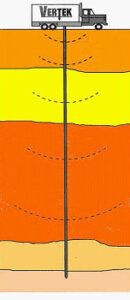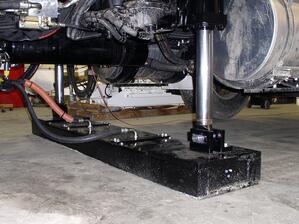
What is Seismic Cone Penetration Testing?
Seismic CPT or SCPT is a method of calculating the small strain shear modulus of the soil by measuring shear wave velocity through the soil. The small strain modulus is an important quantity for determining the dynamic response of soil during earthquakes, explosive detonations, vibrations from machinery, and during wave loading for offshore structures. The wave speeds and moduli derived from seismic CPT measurements aid in the determination of soil liquefaction potential and improve the interpretation of surface seismic surveys by providing wave speed profiles as a function of depth. Seismic waves from SCPT tests have been detected at depths of up to 300 feet.
How does it work?
SCPT testing is performed as part of a normal CPT or CPTU test. Equipment consists of a CPT rig, push system, and:
- SCPT Cone: The SCPT cone is a CPT or CPTU cone that is equipped with one or more geophone sensors. These sensors measure the magnitude and arrival time of seismic shear and compression waves.
 Wave Generator: Seismic shear waves are generated at the soil surface in one of two ways:
Wave Generator: Seismic shear waves are generated at the soil surface in one of two ways:
- The simplest method is to press a steel bar onto the ground lengthwise using the weight of the CPT rig, then strike the end of the bar with a large hammer. An electronic trigger attached either to the hammer or the bar records the exact time of the strike.
- Another method uses an electronic wave generator attached to the CPT rig. This method increases repeatability and reduces physical strain and testing time for the field team.
The CPT test must be paused briefly at the desired intervals to perform the wave generation and data collection. These pauses may be used to conduct a pore pressure dissipation test as well.
- Data Acquisition System: As seismic waves are registered by the geophone sensors, data is transferred from the cone to the soil surface by wires that run though the push rods. The SCPT data acquisition system logs this data and analyzes it to determine the speed of the waves based on their arrival time and the distance between the wave generator and the sensors. Finally, the wave speed is used to calculate shear modulus, soil liquefaction risk and other parameters.
 Adding seismic testing to your CPT test is simple and cost-effective if you have the proper equipment. Seismic technology is an integral part of Vertek’s CPT systems: all our digital CPT cones contain integrated dual-axial or tri-axial geophone sensors, and the Vertek DataPack 2000 data acquisition system is fully compatible with seismic data. Thus, seismic testing requires minimal set-up time beyond what is needed for a normal CPT test. If you outfit your CPT rig with an electronic wave generator, collecting seismic data is as simple as pressing a button. If you’d like to learn more about seismic CPT, check out our catalog or visit our website to watch a demo of the equipment.
Adding seismic testing to your CPT test is simple and cost-effective if you have the proper equipment. Seismic technology is an integral part of Vertek’s CPT systems: all our digital CPT cones contain integrated dual-axial or tri-axial geophone sensors, and the Vertek DataPack 2000 data acquisition system is fully compatible with seismic data. Thus, seismic testing requires minimal set-up time beyond what is needed for a normal CPT test. If you outfit your CPT rig with an electronic wave generator, collecting seismic data is as simple as pressing a button. If you’d like to learn more about seismic CPT, check out our catalog or visit our website to watch a demo of the equipment.

Leave A Comment